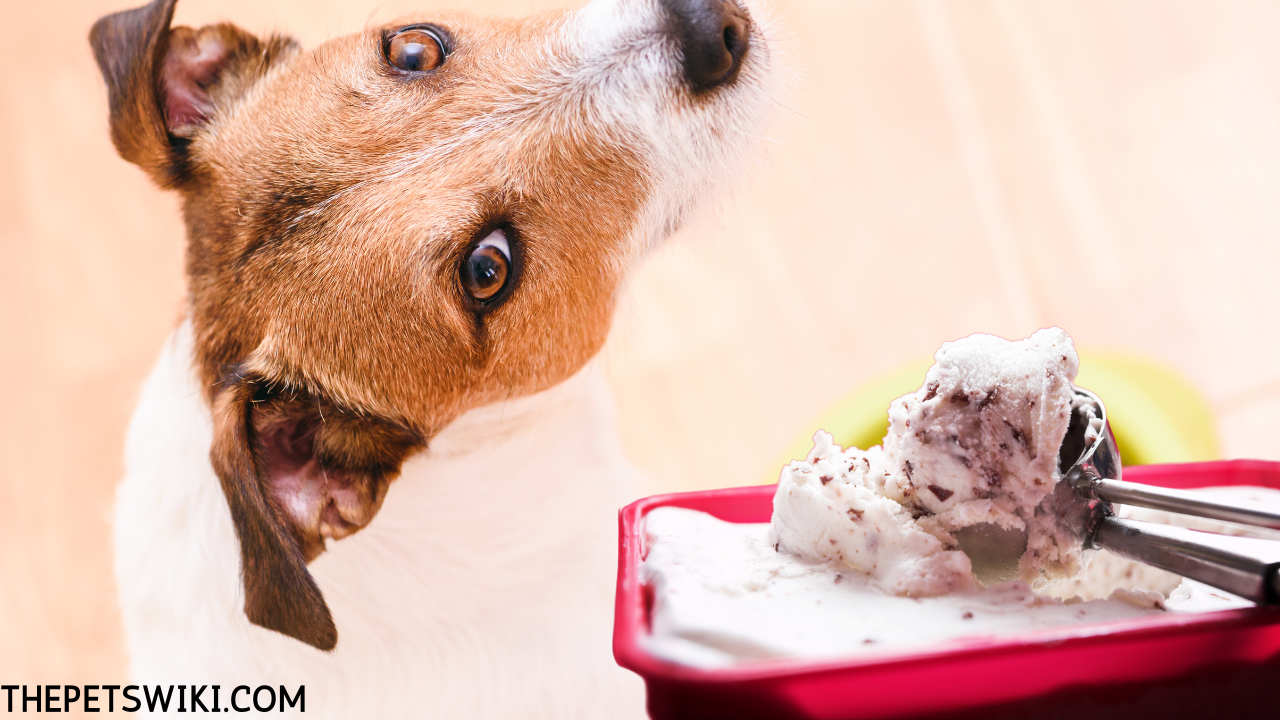Dogs are not just pets; they are cherished members of our families. As responsible pet owners, we often find ourselves contemplating what treats we can share with our furry friends.
One common query that arises is, “Can dogs eat vanilla bean ice cream?” In this article, we will delve into the safety and risks associated with letting your canine companion indulge in this frozen delight.
Can My Dog Eat Vanilla Bean Ice Cream?
Yes, dogs can eat vanilla bean ice cream, but due to its dangerous ingredients like Xylitol, we do not recommend giving it.
While it’s not typically considered dog-friendly food, sometimes you can share a bite or two with your furry friend without causing harm.
Dangerous Icecream Ingredients For Dogs
Ice cream can contain several ingredients that are potentially dangerous for dogs. Some of these ingredients include:
Xylitol
This artificial sweetener is toxic to dogs and can cause a rapid release of insulin, leading to hypoglycemia (low blood sugar), seizures, and liver failure.
Chocolate
Many ice cream flavors contain chocolate, which contains theobromine and caffeine, both of which are toxic to dogs and can cause vomiting, diarrhea, rapid breathing, increased heart rate, seizures, and even death.
Grapes and Raisins
Some ice cream flavors may contain grapes or raisins, which can cause kidney failure in dogs if ingested.
Macadamia Nuts
Ice cream with macadamia nuts can be harmful to dogs and may cause weakness, vomiting, tremors, and hyperthermia. Check out our related article Can Dogs Eat Water Chestnuts?
High-Fat Content
Ice cream is high in fat, which can lead to pancreatitis in dogs, a painful and potentially life-threatening condition.
Lactose
Dogs may be lactose intolerant, and consuming dairy products like ice cream can lead to digestive upset, including diarrhea and vomiting.
It’s essential to avoid feeding ice cream to dogs, especially those containing these harmful ingredients. Instead, opt for dog-friendly frozen treats specifically formulated for canine consumption or homemade treats made from safe ingredients. Always consult with your veterinarian if you suspect your dog has ingested something toxic or if you have any concerns about their diet and health.
Why Is Xylitol Toxic To Dogs?
Xylitol, a sugar substitute often found in sugar-free products, has become a popular choice for those looking to reduce their sugar intake. While it’s considered safe for humans, it poses a severe threat to our canine companions. Understanding why xylitol is toxic to dogs is crucial for responsible pet ownership.
1. Metabolism Discrepancy:
Humans and dogs metabolize xylitol differently. In people, this sugar substitute does not trigger a significant insulin release. However, in dogs, the ingestion of xylitol causes a rapid and massive release of insulin from the pancreas.
2. Hypoglycemia (Low Blood Sugar):
The surge in insulin levels leads to a drastic drop in blood sugar levels, resulting in hypoglycemia. This condition can manifest within 10 to 60 minutes after xylitol consumption and may lead to seizures, loss of coordination, and, in severe cases, coma.
3. Liver Damage:
Xylitol can cause damage to a dog’s liver. In addition to the insulin release, it prompts the liver to release an excessive amount of insulin, leading to liver failure. The liver’s inability to cope with this demand can result in irreversible damage.
4. Coagulopathy (Bleeding Disorders):
Studies have shown a correlation between xylitol ingestion and the development of coagulopathy in dogs. This disorder affects the blood’s ability to clot, potentially leading to uncontrolled bleeding and bruising.
5. Rapid Onset of Symptoms
Unlike some toxins that may take time to show effects, xylitol toxicity in dogs manifests rapidly. This swift onset of symptoms makes it crucial for pet owners to seek immediate veterinary attention if they suspect their dog has ingested any product containing xylitol.
6. Small Amounts Can Be Lethal
Even a small amount of xylitol can be lethal to dogs. The toxic dose varies depending on the size and breed of the dog, but even a small amount found in sugar-free gum or candy can pose a significant risk.
7. Lack of Xylitol Metabolism Education
Many pet owners may not be aware of the dangers xylitol poses to dogs. This lack of education can lead to accidental ingestion, especially when dogs are known for their curious nature and tendency to explore their surroundings.
8. Prevalence in Everyday Products
Xylitol is increasingly used in various everyday products, from chewing gum and toothpaste to baked goods and sugar-free snacks. This ubiquity raises the likelihood of accidental ingestion by dogs.
9. Lack of Immediate Treatment
Due to the rapid onset of symptoms, immediate treatment is crucial for dogs exposed to xylitol. Delayed veterinary care may result in irreversible damage or, in severe cases, death.
10. Heightened Sensitivity in Some Breeds
Certain dog breeds, such as German shepherd mixes, have shown heightened sensitivity to xylitol. Understanding the susceptibility of specific breeds is essential for tailoring preventive measures.
Best Alternatives to Ice Cream For Dogs
Let’s explore some of the best alternatives to ice cream for dogs.
1. Frozen Yogurt
Low in lactose and a good source of probiotics, plain frozen yogurt can be an excellent treat for dogs. Ensure it’s free from artificial sweeteners and additives.
2. Pumpkin Ice Cream
Rich in fiber and low in calories, pumpkin ice cream is a tasty and nutritious alternative. Make a homemade version using pureed pumpkin, plain yogurt, and a touch of honey.
3. Coconut Milk Ice Cream
Coconut milk is a dairy-free option that many dogs enjoy. Look for coconut milk ice cream without added sugars or xylitol, and your dog can relish a tropical-inspired treat.
4. Frozen Banana Slices
Frozen banana slices are a simple and healthy alternative. Not only do they offer a sweet taste, but bananas also provide potassium and other essential nutrients.
5. Watermelon Popsicles
Watermelon is hydrating and low in calories, making it a refreshing choice. Freeze watermelon chunks or blend them with a bit of water and freeze them for a delightful, dog-friendly popsicle.
6. Berry Smoothie Cubes
Blend dog-safe berries like blueberries or strawberries with plain yogurt and freeze in ice cube trays. These berry smoothie cubes are a delicious and nutritious summer treat.
7. Apple Sauce Ice Cream:
Unsweetened applesauce is a canine-friendly option. Mix it with plain yogurt or freeze it in silicone molds for a cool and fruity delight.
8. Carrot Frozen Treats
Rich in vitamins and low in calories, carrots make a crunchy and satisfying frozen treat for dogs. Simply freeze carrot sticks or blend them with a bit of water and freeze them in molds.
9. Peanut Butter Popsicles
Dogs often love peanut butter, and frozen peanut butter popsicles can be a hit. Ensure the peanut butter doesn’t contain xylitol, which is toxic to dogs.
Can My Dog Eat Other Flavors of Ice Cream?
No, dogs should not eat other flavors of ice cream, as they may still contain harmful ingredients like xylitol, chocolate, grapes, or macadamia nuts, which can be toxic to dogs.
Can Dogs Eat Vanilla Bean Yogurt?
Yes, dogs can eat plain vanilla bean yogurt in moderation. However, it’s essential to ensure that the yogurt does not contain any harmful additives like xylitol or chocolate, which can be toxic to dogs. Additionally, yogurt should only be given as an occasional treat and not as a regular part of your dog’s diet.
Conclusion
In conclusion, exploring safe alternatives to traditional ice cream for dogs opens up a world of delicious possibilities that cater to both their taste preferences and nutritional needs. From frozen yogurt to homemade popsicles crafted with wholesome ingredients, pet owners have a variety of options to treat their furry friends responsibly. It’s essential to prioritize canine health by avoiding ingredients harmful to dogs, such as xylitol, and to introduce new treats gradually to monitor for any adverse reactions. By incorporating these tasty alternatives into your dog’s treat repertoire, you can enhance the joy of sharing special moments with your beloved canine companion while ensuring their well-being.


